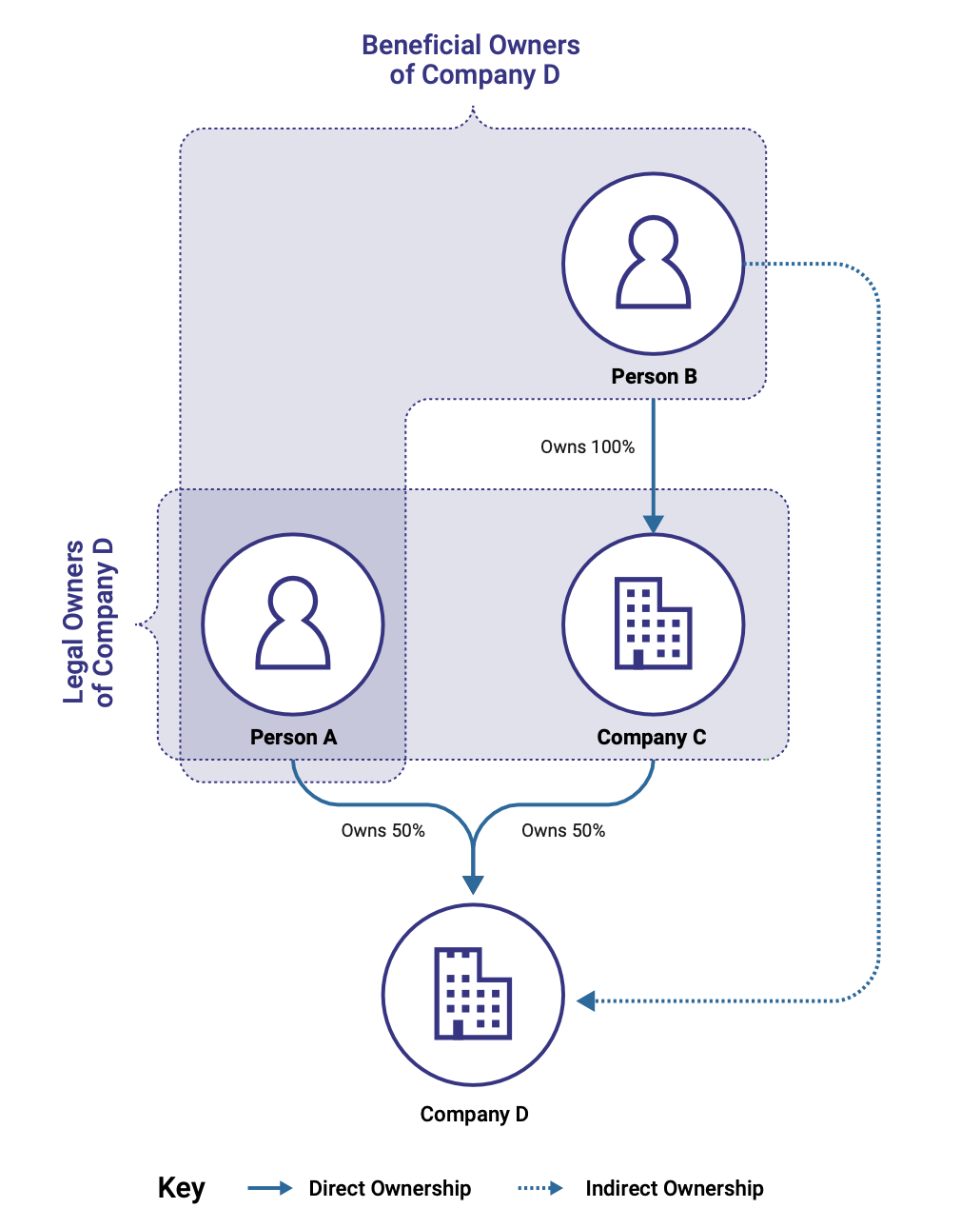Shining a light on company ownership: The role of beneficial ownership transparency in the energy transition
The global movement toward beneficial ownership transparency
Beneficial ownership transparency reveals how companies and other legal entities are ultimately owned and controlled, and by whom. Since 2015, over one hundred jurisdictions have adopted laws requiring companies and other legal entities, and arrangements (e.g. trusts) to disclose information about their beneficial owners.[1]
A beneficial owner is a natural person at the end of an ownership chain with the right to some share of the income or assets (referred to as ‘ownership’) of a legal entity, such as a company or trust, or the right to direct or influence the entity’s activities (referred to as ‘control’).
Historically, information about the ownership and control of companies has been mostly limited to the immediate (or legal) owners.[2] However, as companies can be owned by other companies, this does not always provide information about the individuals behind them.
Using beneficial ownership data
Beneficial ownership transparency is widely recognised for its utility in the fight against corruption, tax evasion, money laundering and the financing of terrorism.[3] It also has applications in policy areas such as public procurement,[4] national security [5] and natural resource governance.[6] For example, beneficial ownership data can improve procurement by helping detect bid-rigging through shared ownership and by detecting conflicts of interest between companies bidding for contracts and decision makers. Making this data public gives civil society and the public oversight over government spending of taxpayer money.[7]
Figure 1. Legal and beneficial ownership explained

Source: Reproduced from Open Ownership (March 2021), Beneficial ownership data in procurement.
In this stylised representation of a company ownership chain, Person A and Company C are the legal owners of Company D. Person B is the legal owner of Company C. Person A and Person B are the beneficial owners of Company D. Person A exercises their ownership directly, while Person B exercises their ownership indirectly through Company C. Company C cannot be a beneficial owner as it is not a natural person.
Beneficial ownership transparency and the EITI
Robust beneficial ownership disclosure is a priority area under the Extractive Industries Transparency Initiative (EITI), which implements the global standard to promote the open and accountable management of oil, gas and mineral resources. Beneficial ownership requirements in the 2019 EITI Standard promote access to quality beneficial ownership data to strengthen accountability in the extractive sector. Beneficial ownership information can improve governance of natural resource revenues, support business, curtail corruption and illicit financial flows, and support asset recovery.[8]
Beneficial ownership transparency reform in the extractives has significant support from the private sector.[9] EITI supporting companies uphold the EITI Standard through reporting in EITI implementing countries where they operate, and agree to meet the Expectations for EITI supporting companies, including publicly declaring and publishing support for beneficial ownership transparency and publicly disclosing beneficial owners in line with the EITI Standard.[10]
Endnotes
- Open Ownership (no date), “Worldwide commitments and action”. Retrieved from https://www.openownership.org/map/ on 10 February 2022.
- Please refer to https://www.openownership.org/what-is-bot/ for more information. Page accessed 8 March 2022.
- Please refer to https://www.openownership.org/principles/ for more information. Page accessed 8 March 2022.
- Please refer to https://www.openownership.org/resources/beneficial-ownership-data- in-procurement/ for more information. Page accessed 8 March 2022.
- Please refer to https://www.openownership.org/uploads/oo-briefing-using-bo-data-for-national-security-2021-12.pdf for more information. Page accessed 8 March 2022.
- Please refer to https://www.openownership.org/resources/catalysing-transformative-change-in-beneficial-ownership-transparency/ for more information. Page accessed 8 March 2022.
- Okunbor, E. and T. Kiepe (March 2021), Beneficial ownership data in procurement, Open Ownership. Retrieved from https://www.openownership.org/resources/beneficial-ownership-data-in-procurement/ on 3 March 2022.
- EITI and Open Ownership (August 2020), “Opening Extractives Programme Proposal”. Note: as of January 2022, the EITI has raised the standards for beneficial ownership disclosure among its 56 implementing countries, requiring them to provide detailed information about companies’ ownership structures, to identify politically exposed persons, and to name entities that fail to disclose all or parts of their beneficial ownership transparency information. Please refer to https://eiti.org/document/2021-eiti-validation-guide#req25 for more information. Page accessed 8 March 2022.
- Open Ownership (September 2021), “Six of the largest extractive companies commit to a common set of policies and practices on beneficial ownership transparency”. Retrieved from https://www.openownership.org/news/six-of-the-largest-extractive-companies-commit-to-a-common-set-of-policies-and-practices-on-beneficial-ownership-transparency/ on 21 February 2022.
- EITI (January 2022), “Expectations for EITI supporting companies”. Retrieved from https://eiti.org/document/expectations-for-eiti-supporting-companies on 21 February 2022.
Next page: Changing context for beneficial ownership transparency reform